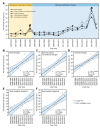Revisiting the Complex Pathosystem of Huanglongbing: Deciphering the Role of Citrus Metabolites in Symptom Development
- PMID: 33066072
- PMCID: PMC7600524
- DOI: 10.3390/metabo10100409
Revisiting the Complex Pathosystem of Huanglongbing: Deciphering the Role of Citrus Metabolites in Symptom Development
Abstract
Huanglongbing (HLB), formerly known as citrus greening disease, is one of the most devastating bacterial diseases in citrus worldwide. HLB is caused by 'Candidatus Liberibacter asiaticus' bacterium and transmitted by Diaphorina citri. Both 'Ca. L. asiaticus' and its vector manipulate the host metabolism to fulfill their nutritional needs and/or to neutralize the host defense responses. Herein, we discuss the history of HLB and the complexity of its pathosystem as well as the geographical distribution of its pathogens and vectors. Recently, our recognition of physiological events associated with 'Ca. L. asiaticus' infection and/or D. citri-infestation has greatly improved. However, the roles of citrus metabolites in the development of HLB symptoms are still unclear. We believe that symptom development of HLB disease is a complicated process and relies on a multilayered metabolic network which is mainly regulated by phytohormones. Citrus metabolites play vital roles in the development of HLB symptoms through the modulation of carbohydrate metabolism, phytohormone homeostasis, antioxidant pathways, or via the interaction with other metabolic pathways, particularly involving amino acids, leaf pigments, and polyamines. Understanding how 'Ca. L. asiaticus' and its vector, D. citri, affect the metabolic pathways of their host is critical for developing novel, sustainable strategies for HLB management.
Keywords: Asian citrus psyllid; Diaphorina citri; blotchy mottle; citrus; flushing cycles; fruit drop; huanglongbing; metabolites; phytohormones; polyamines; root damage; ‘Candidatus Liberibacter’.
Conflict of interest statement
The authors declare there are no conflicts of interest.
Figures






Similar articles
-
'Candidatus Liberibacter americanus', associated with citrus huanglongbing (greening disease) in São Paulo State, Brazil.Int J Syst Evol Microbiol. 2005 Sep;55(Pt 5):1857-1862. doi: 10.1099/ijs.0.63677-0. Int J Syst Evol Microbiol. 2005. PMID: 16166678
-
Made for Each Other: Vector-Pathogen Interfaces in the Huanglongbing Pathosystem.Phytopathology. 2022 Jan;112(1):26-43. doi: 10.1094/PHYTO-05-21-0182-FI. Epub 2022 Jan 14. Phytopathology. 2022. PMID: 34096774 Review.
-
'Candidatus Liberibacter asiaticus' and Its Vector, Diaphorina citri, Augment the Tricarboxylic Acid Cycle of Their Host via the γ-Aminobutyric Acid Shunt and Polyamines Pathway.Mol Plant Microbe Interact. 2019 Apr;32(4):413-427. doi: 10.1094/MPMI-09-18-0238-R. Epub 2019 Feb 15. Mol Plant Microbe Interact. 2019. PMID: 30284953
-
First Report of the Citrus Huanglongbing Associated Bacterium 'Candidatus Liberibacter asiaticus' from Sweet Orange, Mexican Lime, and Asian Citrus Psyllid in Belize.Plant Dis. 2010 Jun;94(6):781. doi: 10.1094/PDIS-94-6-0781A. Plant Dis. 2010. PMID: 30754326
-
Progress and Obstacles in Culturing 'Candidatus Liberibacter asiaticus', the Bacterium Associated with Huanglongbing.Phytopathology. 2019 Jul;109(7):1092-1101. doi: 10.1094/PHYTO-02-19-0051-RVW. Epub 2019 Jun 3. Phytopathology. 2019. PMID: 30998129 Review.
Cited by
-
Diaphorina citri Genome Possesses a Complete Melatonin Biosynthesis Pathway Differentially Expressed under the Influence of the Phytopathogenic Bacterium, Candidatus Liberibacter asiaticus.Insects. 2021 Apr 1;12(4):317. doi: 10.3390/insects12040317. Insects. 2021. PMID: 33916117 Free PMC article.
-
Identifying the earliest citrus responses to Candidatus Liberibacter asiaticus infection: a temporal metabolomics study.Front Plant Sci. 2024 Nov 6;15:1455344. doi: 10.3389/fpls.2024.1455344. eCollection 2024. Front Plant Sci. 2024. PMID: 39574442 Free PMC article.
-
Insights into the mechanism of Huanglongbing tolerance in the Australian finger lime (Citrus australasica).Front Plant Sci. 2022 Oct 21;13:1019295. doi: 10.3389/fpls.2022.1019295. eCollection 2022. Front Plant Sci. 2022. PMID: 36340410 Free PMC article.
-
Gamma-Aminobutyric Acid Accumulation Contributes to Citrus sinensis Response against 'Candidatus Liberibacter Asiaticus' via Modulation of Multiple Metabolic Pathways and Redox Status.Plants (Basel). 2023 Nov 2;12(21):3753. doi: 10.3390/plants12213753. Plants (Basel). 2023. PMID: 37960112 Free PMC article.
-
Virus-induced gene silencing simultaneously exploits 'attract and kill' traits in plants and insects to manage huanglongbing.Hortic Res. 2024 Nov 6;12(2):uhae311. doi: 10.1093/hr/uhae311. eCollection 2025 Feb. Hortic Res. 2024. PMID: 39944988 Free PMC article.
References
-
- Bové J., Garnier M. Phloem-and xylem-restricted plant pathogenic bacteria. Plant Sci. 2003;164:423–438. doi: 10.1016/S0168-9452(03)00033-5. - DOI
Publication types
Grants and funding
LinkOut - more resources
Full Text Sources

